| “Unique methodology of injury prevention, pain management, rehabilitation, conditioning & peak performance training based on balanced water and land exercises.” |
From East to West - Igor's Life Story
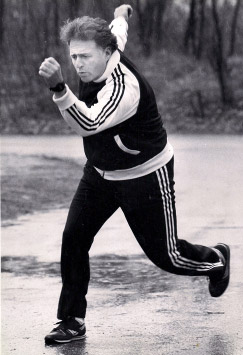 |
Igor Burdenko was born in Kiev, the capital of Ukraine, in July 1935. He lived with his parents and grandmother in a tiny apartment in the city. When the German army invaded the former Soviet Union, they advanced into the USSR very rapidly and during the first days of the World War II Kiev was heavily bombed. Igor’s father was immediately mobilized and the family was evacuated deep into the country. The evacuation echelons were constantly bombed and many people died. Igor’s family was fortunate, they made it first to the Caucasus Mountains and then to the Ural Mountains. He had to be the “man” of the family to take care of his mother, grandmother, aunt, and two cousins. Being in the mountain regions, he had to help with all the household chores such as collecting wood for the stoves, bringing water from the well, etc... |
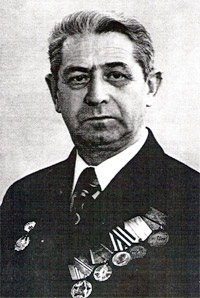 |
In May 1945, World War II ended and the family returned to Kiev in 1946. During the war many schools had been closed and Igor’s education was sporadic. Now, he had to catch up. He remembers the very first question from his teacher, “Raise your hand if your father came back from the war?” In a class of approximately forty children, only three raised their hands. He was one of them. Igor’s father returned from the war severely disabled. He was wounded five times in the leg, arm, back, stomach, and shoulder. This resulted in his inability to walk. During this time there were no wheelchairs, just a few pharmacies, and limited access to doctors. Many of the doctors perished in the war. Igor’s father survived because Igor’s grandmother helped him using alternative medicine such as herbs, home remedies, stones, praying, and meditation. Before the war, Igor's father was a good swimmer and he was in a great shape. He taught Igor how to swim before Igor knew how to walk. Thus, when he came home from the war so badly wounded, he turned to water for healing. During Igor’s childhood, water was widely used for recovering from pain and fatigue. Not far from where Igor and his family lived in Kiev, there was a small pond full of children playing and fishing. Igor’s father asked him to help him get to this pond. How Igor accomplished this he still doesn’t know because he was a little boy and his father was a big man. In the water, his father felt much better with less pain and more mobility. He couldn’t actually swim because of his wounds, so he maintained a vertical position in the water without touching the bottom. He would make small movements with his body (legs and arms) to keep him upright. It was remarkable to be suspended that way in the water. These small movements helped relieve the pain and began to enable him to move again. Slowly, he returned to his former self and was able to move to America in 1979, two years before Igor did. Igor believes that his father would not have recovered if it weren’t for the water exercise and alternative medicine. This experience had a great influence on Igor and his thinking about injuries and recovery. At this point in his life, Igor had very special feelings towards the water, which he finds difficult to describe. These feelings for water have profoundly influenced his whole life and the professional path he has chosen. Igor’s own efforts to stay vertical in the water (without touching the bottom) as his father did, were unsuccessful. However, over a period of time, Igor trained himself to stay suspended upright, which is the same exercise he trains his clients to perform. This vertical position is very important for body alignment, traction, and healing. |
Igor liked studying in school, especially gym class. He began competing in speed skating when he was eleven. He participated in competitions with the best skaters in Ukraine and was the champion for speed skating in his age group. The love for this sport led him to go to the Latvian State Sports University. In 1958, he graduated with a Master’s degree in Physical Education and Exercise Physiology in Riga, Latvia. At the university, Igor discovered his special interest in training and developed six essential elements: balance, coordination, flexibility, endurance, speed, and strength for everyday life and sport. He took many educational classes and participated in conferences. His main focus was on how to recover after training and how to use water and land exercises to develop the human body as well as prevent injuries.
Igor remembers when he was a college student, he saw a high voltage wire fall onto a small pig. The pig collapsed showing no signs of life. Igor and his friends carried the small animal to a ditch filled with water and placed the pig in it. Igor started to massage the pig and move its legs. Although initially in shock, the pig came back to life and in a few minutes ran off as if nothing happened. The movement in the water revived him and Igor was impressed with the effects of water once again.
Many animals who live in the wild do not have a fear of water. For instance, in an experiment where a chicken egg was placed into a duck’s nest and a startling result was observed. Once the chick hatched, it followed the ducklings into the water and swam with them. What is instinctive in birds is not necessarily the case for humans, who have to be taught how to swim and be comfortable in the water. Igor believes that it is important for humans to overcome all their inhibitions of water and that all creatures can naturally be comfortable and feel safe in the water.
Between 1958 and 1962 Igor had a variety of sports related jobs. After graduating from the university he was sent to work in Moscow in a sports organization. His position was a senior trainer in cross-country skiing. He was in charge of training the most important team representing the Moscow suburbs. In 1962, he started working as a gym teacher in a school in Moscow. He was eventually appointed as a professor at the University of Advanced Training of Teachers and Coaches. For sixteen years he was one of the editors of the magazine Physical Education in Schools and published over a hundred articles about rehabilitation, conditioning, and training. In 1973, his first book was published, Textbook for Physical Education Teachers. In 1979, before the Olympics in Moscow, Igor and his colleague Georgy Rechetnikov, published a book titled Moscow-Children’s Sport. This was soon followed by another book about the most famous cross country Olympic champion couple, Pavel and Aleftina Kolchin. It was titled About Skiing and Me. For five years he was a professor in clinical affiliation with students from the Moscow Pedagogical University. Over the years, Igor continued writing and has published four books in the United States: Ultimate Power of Resistance (1992), Overcoming Paralysis (1999), Overcoming Injuries (2007), and The Burdenko Method (2012). Igor regularly presents his work at national conferences and symposiums for health and fitness.
In 1981, Igor and his family immigrated to Boston, Massachusetts. It was very difficult to find a job, because he didn’t speak English. Water therapy at this time didn’t exist in the United States. The organization which helped Igor write his resume didn’t know what to do with him. They sent his resume to universities, sports clubs, hospitals, and private physical therapy clinics.
One of his resumes came to the attention of Dr. Lyle Micheli, Chief of the Sports Medicine Division at Boston Children’s Hospital. He was a top-echelon surgeon who understood and valued rehabilitation. As President of the American College of Sports Medicine, he was very interested in Igor’s achievements in sports medicine, rehabilitation, and in Igor’s books and articles published in the former Soviet Union. He invited Igor for an interview and this was the turning point for Igor’s career in the United States.
Dr. Micheli advised Igor to go to a physical therapy office in Dedham. This was a clinic located at a sports club where many members of the New England Patriots football team and members of the Boston Ballet worked out. The owner of the club was a football coach and helped introduce Igor to the staff as well as some of the players. He told them Igor couldn’t speak English but would “talk with his hands”. Some club members as well as team members became intrigued by Igor’s work. They had never seen anything like it! New England Patriots players such as Lin Dawson, Mark Buben, John Smith, and Allen Clark used Igor’s service regularly after workouts and for recovery/rehabilitation from injuries.
During these years, it was very difficult to find swimming pools with a deep end in the Greater Boston area. An advanced tennis player, Paul Sullivan, asked Igor if he could help him recover after he completely ripped his Achilles tendon. The surgery had left him unable to play tennis at all. His doctor had told him he would never play again. Igor said he would try to help Paul if a swimming pool with a deep end and a studio for land exercises could be located. He advised Paul to seriously commit to the program he had developed for him. The tennis player agreed. Igor began working with Paul in Wayland at a sports club that provided such facilities. In six months, Paul Sullivan started to play tennis again.
Igor continued practicing his method and many people became interested in his water therapy. Some club members recognized his impressive results. Soon enough, his training became popular which helped tremendously in starting his business, The Burdenko Water and Sports Therapy Institute. This business has now been active for more than 30 years and from the very beginning has drawn the attention of physical therapists, doctors, coaches, amateur and professional athletes, as well as ordinary people. It has offered Igor the opportunity to show the public how efficient and safe it can be to use water as a modality to rehabilitate, condition, and train.
People come to the Burdenko Water and Sports Therapy Institute in Boston from all over the world to restore their health and educate themselves about the Burdenko Method. They come from such countries as Australia, Belgium, Canada, Denmark, South Africa, as well as different states in the U.S. Instructors (trained by Igor) work with members of state and national sports teams. More than a thousand people are certified in the Burdenko Method and twenty-five of them are Master Certified. Five Olympic champions are certified in the Burdenko Method. Igor constantly develops new equipment and new exercise programs. The most popular health and fitness resort in the U.S., Canyon Ranch, includes programs based on the Burdenko Method, both in the water and on land.
The 2007 Global Lifetime Achievement Award from the Aquatic Exercise Association for “Many Years of Leadership, Innovation and Dedication to the Aquatic Fitness Industry” is one of Dr. Burdenko's many accolades.
Personal Reminiscence:
“I have had students and clients in most Olympic Games who not only participate, but have won gold, silver, and bronze medals. In my work, I have come across many celebrities, from the Soviet Union, the US, and Canada. I have helped them to be in their best shape and be ready to compete at State, National, International, World Championship, and Olympic levels.
My method is highly diversified. I work with athletes at the highest level of their respective sports. Dancers, divers, skiers, runners, basketball players, football players, baseball players, hockey players, and Para-Olympic competitors--a wide variety of people and abilities. All of them have a few qualities in common: they are able to focus, they work relentlessly, and they have talent. All of them have offered me great challenges and incredible pleasure to work with them and to witness their progress.”
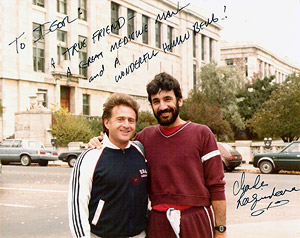 |
One of many clients was Charles Laquidara. His personality was well known in the Boston area, because he was of one of the best DJs in the country and a prominent TV personality in the 1970's, 1980's, and 1990's. Many people listened to his WBCN morning show. He had excruciating pain in his lower back to the point that it was jeopardizing his public presence on the radio and TV. Through his radio station he asked the public to recommend him a “Miracle Man.” Somebody called him and gave Igor’s name. Charles was laying down on a futon in the back of his wife’s car while she was driving him to see Igor. The work had started. Igor developed a program for Charles. It included simple exercises (how to lay down, how to sit, how to stand, how to walk, how to turn, how to go up and down the stairs, etc...) focusing on reducing impact to his joints. Igor was teaching Charles how to move painlessly. Charles started practicing this routine in the water (to decompress the body) and on land. At the beginning Charles was skeptical. Once Charles’ pain began to diminish and he saw steady progress, he became more confident in the Burdenko Method. He was surprised how simple exercises can reduce pain significantly. In less than a year, he participated in a fundraising event – a 10K run in downtown Boston. His friends, listeners, and colleagues congratulated him. He was back in the "game!" From that point on, Charles would not stop talking about the Burdenko Method. He wanted to share his experience in order to help the public. Even today, Charles continues to implement his water and land programs every day to maintain his great shape physically, spiritually, and to lead a productive life. |
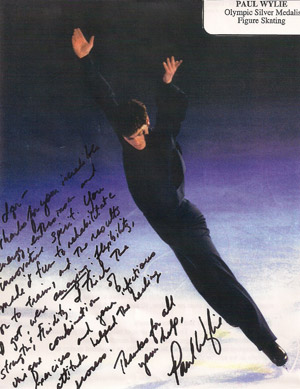 |
“My other students – a Canadian diver, Alexandre Despatie, won a silver medal in 2008; Paul Wylie, a U.S. figure skater, also won a silver; Nancy Kerrigan, another U.S. figure skater, won a silver; Oksana Baiul, a Ukrainian figure skater, won a gold; and in the 2014 Winter Olympics in Sochi, Russia, Larisa Yurkiw from Canada participated in downhill skiing. The youngest client is four years old but doesn’t participate in competitions yet. The oldest client is ninety-five years old and still competing and winning medals. I worked with a variety of figure skaters. I remember the joy I experienced helping Paul Wiley participate in the 1992 Winter Olympics in Albertville, France. He won a silver medal in figure skating there. He is a great example showing how much can be achieved combining education, a career, and a family. |
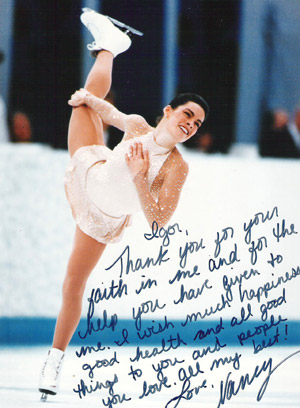 |
Many people remember the saga of Nancy Kerrigan. Her injury occurred just seven weeks before the 1994 Lillehammer Winter Olympics. Nancy experienced great pain and shock. It presented a serious challenge for her to keep her focus and maintain a positive attitude during her rehabilitation and training. She managed to do all of that. While I was working with her, she was totally committed to the training. The incredible result was an Olympic Silver Medal. In my opinion, her silver medal is edged with gold. Her achievement was remarkable as a human being and as an athlete. |
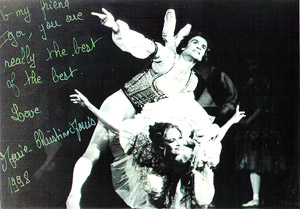 |
It has been a memorable experience for me to work with ballet stars. I had the chance to guide Rudolf Nureyev in restoring his energy after rehearsals and performances. I also worked with his partner, Marie-Christine Mouis, a leading star at the Boston Ballet, helping her to recover from injuries. I showed her new exercises in the water where she danced part of her stage routines. Her grace was so memorable. |
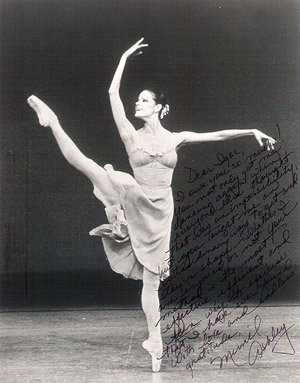 |
Merrill Ashley, the leading star of the New York City Ballet, a student of George Balanchine, prolonged her dancing career after two surgeries on her joints. I worked with Merrill before and after surgeries. It is very important the shape a person is in before going into the operating room. The better shape one is in, the faster the recovery will be. By practicing the Burdenko Method, Merrill gave herself the ability to teach and consult ballet companies all over the world. |
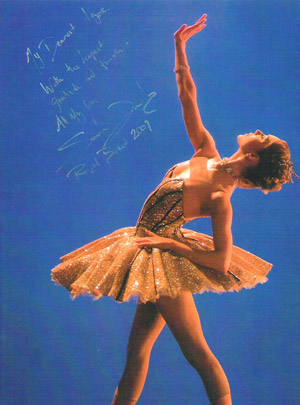 |
Another celebrity I worked with was a prima ballerina of the London Royal Ballet, Sarah Lamb. She came to me with a severe injury from which most dancers never fully recover. She had broken four metatarsals in her foot and had a very complicated surgery. She flew to Boston to work with me in the water and on land. The water was a new experience for her and she brought total focus to her work. She practiced her rehabilitation program two times a day, five days a week. She was exceptional in her will to recover and in her dream of returning to the stage, a dream she never lost sight of and achieved with grace and joy. As a prima ballerina, she has been a huge inspiration and example to many athletes and performers worldwide. |
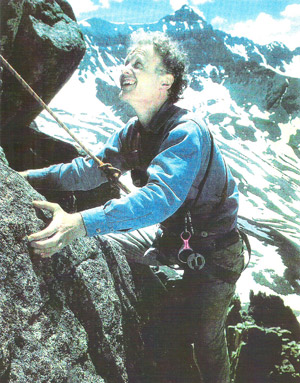 |
Lester Thurow, a world-renown economist (Former Dean of MIT's Sloane School of Business) and a proficient mountain climber, came to me at the beginning of 1980's. He wanted to secure his health, vitality, focus, and ability to climb the highest peaks for years to come. We started working together towards preparing Lester for very demanding expeditions. Through the years, Lester learned more and more of the Burdenko Method. He practiced it systematically. The Burdenko Method helped him combine an intensive lecturing and traveling schedule with such a demanding and challenging activity as conquering mountains. |
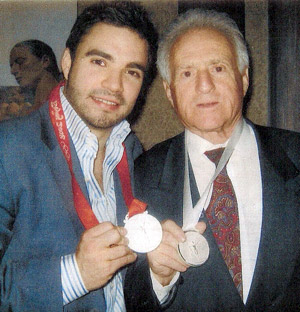 |
Another celebrity I worked with was Alexandre Despatie, a Canadian hero. He has been a three-time world champion and two-time silver medalist in Olympic diving. Three months before the 2008 Olympics, he blew out the fifth metatarsal on his foot. Four years of preparation and training were suddenly lost and he fell into a classic depression; physically, mentally, and spiritually. He came to Boston with his diving partner. He was competing in solo as well as in synchronized diving. He told me, "I have only one choice now, I have you. I have tried everything else. I believe you can help me. You have helped so many." Alexandre worked in the water and on land, where he showed both dedication and talent. New exercise routines in both water and on land helped his spirit come back. His ability to move freely in the water gave him joy as did his performance on land where he mimicked his diving techniques with no pain and great enthusiasm. He made the Canadian Olympic team which lifted the spirits of his teammates as he had been their leader for years and was the most experienced competitor on the team. That year he won a Silver Olympic Medal. |
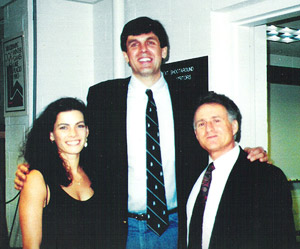 |
I had the chance to work with great basketball players such as Kevin McHale of the Boston Celtics. Kevin had fractured the navicular bone in his foot and was afraid that he might not be able to play in the upcoming season. |
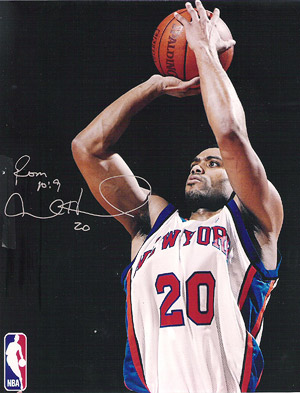 |
Allan Houston of the New York Knicks. Tim Duncan, who recently won a fifth NBA title with the San Antonio Spurs, whom I worked with in 2013. They were all very talented players and all exceptional people. They are a great example of long-term athletes willing to commit to always improving their performance. All came to me to recover from severe injuries and remain in sports. They all made it back onto the court and offer everyone an example of dedication to hard work and persistence in order to recover and play top-level basketball. |
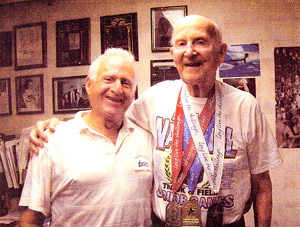 |
William Stern continues to be my hero. Over his long life, he has participated in many distance running competitions. He is ninety-five years old and a champion at the National Senior Games in three distances. He won a gold in the 1500-meter run, a silver in the 400-meter run, and a bronze in the 100-meter run. He is a great spirit and always has a wonderful sense of humor. He gives everyone around him joy and offers a great example of the importance of being in good shape for everyday life and sport. He is a true example of human harmony. |
All these people are like you and I. The reality is that they have committed to physical, mental, and spiritual growth, realizing that the crucial point is developing their own potential on all those levels.
Many people come to me not only to cure injuries, but to prevent them. They realize the importance of staying in the best shape possible in order to continue performing, competing, and playing. I believe everyone should strive to do their best in whatever field they are in and fitness is the key to achievement in any arena. It is essential to well-being and promotes long-term activity in everyday life.”